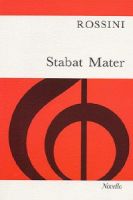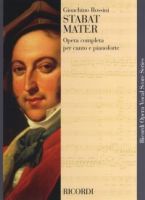Rossini Stabat Mater Vocal Score

Vocal Scores for Rossini's Stabat Mater
Stabat Mater by Gioachino Rossini is based on the traditional structure of the Stabat Mater for chorus and soloists.
The two most popular vocal scores for Rossini's Stabat Mater are shown below.
Rehearsal recordings to help learn your voice part (Soprano, Alto, Tenor, Bass) are described below.
Full video version to hear the work in full is also below
The Novello edition of Rossini's Stabat Mater is in English and Latin for SATB.





The Ricordi edition of Rossini's Stabat Mater is in English, French, German, Italian and Latin for Choral-Mixed accompanied (Chor-Mix).

Catalogue Number: NR4918200
ISMN: 979004049182
Please click here if you wish to order and further vocal score information
Please order by 3pm to be despatched today.




In 1831 Gioachino Rossini was traveling in Spain in the company of his friend the Spanish banker, Alexandre Aguado owner of Château Margaux. In the course of the trip, Fernández Varela, a state councillor, commissioned a setting of the traditional liturgical text, the Stabat Mater. Rossini managed to complete part of the setting of the sequence in 1832, but ill health made it impossible for him to complete the commission. Having written only half the score (nos. 1 and 5-9), he asked his friend Giovanni Tadolini to compose six additional movements. Rossini presented the completed work to Varela as his own. It was premiered on Holy Saturday of 1833 in the Chapel of San Felipe el Real in Madrid, but this version was never again performed.
When Varela died, his heirs sold the work for 2,000 francs to a Parisian music publisher, Antoine Aulagnier, who printed it. Rossini protested, claiming that he had reserved publication rights for himself, and disowned Aulagnier's version, since it included the music by Tadolini. Although surprised by this, Aulangier went ahead and arranged for a public performance at the Salle Herz on October 31, 1841, at which only the six pieces by Rossini were performed. In fact, Rossini had already sold the publication rights for 6,000 francs to another Paris publisher, Eugène Troupenas. Lawsuits ensued, and Troupenas emerged the victor. Rossini finished the work, replacing the music by Tadolini, before the end of 1841. The brothers Léon and Marie Escudier, who had purchased the performing rights of Rossini's final version of the score from Troupenas for 8,000 francs, sold them to the director of the Théâtre-Italien for 20,000 francs, who began making preparations for its first performance.
Rossini's extensive operatic career had divided the public into admirers and critics. The announcement of the premiere of Rossini's Stabat Mater provided an occasion for a wide-ranging attack by Richard Wagner, who was in Paris at the time, not only on Rossini but more generally on the current European fashion for religious music and the money to be made from it. A week before the scheduled concert Robert Schumann's Neue Zeitschrift für Musik carried the pseudonymous essay, penned by Wagner under the name of "H. Valentino", in which he claimed to find Rossini's popularity incomprehensible: "It is extraordinary! So long as this man lives, he'll always be the mode." Wagner concluded his polemic with the following observation: "That dreadful word: Copyright—growls through the scarce laid breezes. Action! Action! Once more, Action! And money is fetched out, to pay the best of lawyers, to get documents produced, to enter caveats.— — —O ye foolish people, have ye lost your hiking for your gold? I know somebody who for five francs will make you five waltzes, each of them better than that misery of the wealthy master's!" Of course, Wagner himself, at the time that he wrote this, was still in his late twenties, and had not yet had much success with the acceptance of his own music in the French capital.
The Stabat Mater was performed complete for the first time in Paris at the Théâtre-Italien's Salle Ventadour on January 7, 1842, with Giulia Grisi (soprano), Emma Albertazzi (mezzo-soprano), Mario (tenor), and Antonio Tamburini (baritone) as the soloists. The Escudiers reported that: "Rossini's name was shouted out amid the applause. The entire work transported the audience; the triumph was complete. Three numbers had to be repeated...and the audience left the theater moved and seized by an admiration that quickly won all Paris."
In March Gaetano Donizetti led the Italian premiere in Bologna with great success. The soloists included Clara Novello (soprano) and Nikolay Ivanov (tenor). Donizetti reported the public's reaction: "The enthusiasm is impossible to describe. Even at the final rehearsal, which Rossini attended, in the middle of the day, he was accompanied to his home to the shouting of more than 500 persons. The same thing the first night, under his window, since he did not appear in the hall."
Despite the fact that the work is markedly different from his secular compositions, northern German critics, as reported by Heinrich Heine in an essay on Rossini, criticised the work as "too worldly, sensuous, too playful for the religious subject." In response the French music historian Gustave Chouquet has remarked that "it must not be forgotten that religion in the South is a very different thing from what it is in the North."
Scored for four vocal soloists – soprano, mezzo-soprano, tenor, bass – , mixed choir, and an orchestra of 2 flutes, 2 oboes, 2 clarinets, 2 bassoons, 4 horns, 2 trumpets, 3 trombones, timpani, and strings.
The poem's 20 verses of 3 lines each are broken variously and deployed among the available forces in many combinations across 10 movements.
1. Stabat Mater dolorosa - Chorus, one verse
2. Cujus animam - Tenor, three verses
3. Quis est homo - Soprano and mezzo-soprano, two verses
4. Pro peccatis - Bass, two verses
5. Eja, Mater - Bass recitative and Chorus, two verses
6. Sancta Mater - Vocal quartet, five verses
7. Fac ut portem - Mezzo-soprano, two verses
8. Inflamatus - Soprano and Chorus, two verses
9. Quando corpus morietur - Chorus, one verse
10. In sempiterna saecula. Amen - Chorus
Written in 1841 for tenor solo, the andantino maestoso section Cuius animam, with its rollicking and memorable tune, is often performed apart from the work's other movements as a demonstration of the singer's bravura technique.
For further information of Rossini's Stabat Mater, please click here to visit the Wikipedia website




ChoraLine 'Voice Part' Rehearsal CDs & EasyPlay (Stream & Download)
Quick and Easy way to memorise your vocal line and practise between choir rehearsals

Know Your Notes Perfectly
Enhance Your Enjoyment when Singing
Learn With The Music
Shine In Your Choir
Sing With Confidence
Please click here to hear a ChoraLine sample for Stabat Mater








